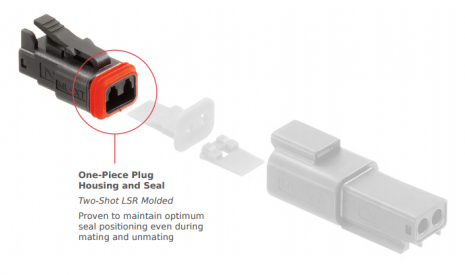In The Field, Two Is Better Than One
A recent Molex survey of agricultural vehicle manufacturers found that 90 percent of connector failures experienced during agricultural vehicle manufacturing and field-use come from sealing issues. Seals fail on between 25 and 500 of every 1,000 connectors used during agricultural vehicle production, and between 10 and 20 of every 1,000 connectors that make it into the field.
For these agricultural vehicles, the only thing that matters is durability. Required to work long hours in harsh, dirty conditions; the reliable performance of these vehicles can make, or break, a farming operation. Daily contact with dust, fuel, chemical contaminants and high-pressure wash-downs puts quite the strain on the complex connection systems within the vehicle. In order to protect these systems, connector sealing is critical.
For decades, the same traditional sealed connector system has been used in agricultural vehicle manufacturing. Over time, these vehicles have become exponentially more electrically complex, and with more connections in the vehicle, more of these traditional connectors are in use. As seal failures began to become more of a problem, industry experts sought to identify the cause. What they determined was that chemical erosion of the silicone seal material was causing separation and loss of adhesion between the seal and the connector body. These silicone seals are an independently molded component, which is then adhered to the connector body. When the adhesion between the seal and connector is compromised, gaps, spacing and even complete seal disconnection is possible. These issues render the seal and connector effectively useless.
Molex acknowledged this issue in the industry well before their first ML-XT™ Sealed Connectors came off of the line. Utilizing creative collaboration on a global scale, Molex sought out a way to create a connector that has not just a better seal, but one that is inseparable from the connector body.

Molex has the ability to mold LSR directly onto a substrate that itself has just been molded, while using the same mold and injection materials.
Investment in LSR two-shot molding technology was critical for the development of such a solution. What this molding technology provides is the ability to mold LSR directly onto a substrate that itself has just been molded, while using the same mold and injection materials. This integrates several functions, parts and materials into one component that is permanently fused via a covalent, or molecular, bond.
The agricultural vehicle market has needed a more reliable sealing solution for some time now. LSR two-shot molding gives Molex the capability to produce bonded connectors like the ML-XT™ Sealed Connector System, helping agricultural vehicle manufacturers to protect their valuable electronic systems more effectively than ever before.